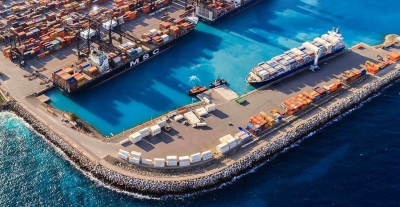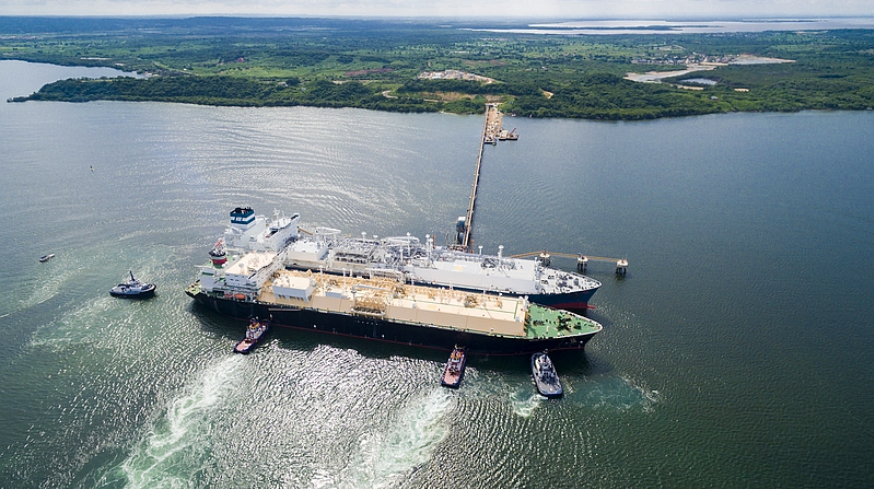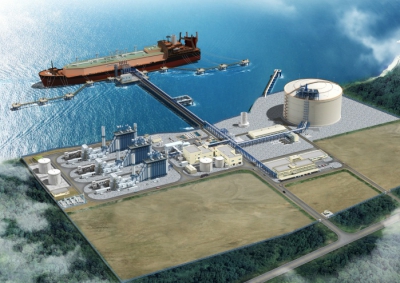[NGW Magazine] Caribbean promises to be LNG growth market
The Caribbean basin is no stranger to extreme weather so will need resilient gas and power infrastructure to reinvent itself as a clean air, niche market for some of the world’s surplus LNG. New downstream technology is also coming to market.
With a global LNG supply glut expected to last until 2023-24, many LNG producers and traders are looking to emerging markets to place their surplus volumes.
The Caribbean basin’s LNG demand is expected to grow from around 2mn metric tons (mt) in 2016 to 12mn mt in 2024 and on to 16mn mt in 2034, according to consultancy Wood Mackenzie this summer.
It says the region relies on fuel oil and diesel for more than half its power plant fuel – except hydro-reliant Colombia – but it wants to develop new gas-fired capacity and supply LNG as a bunker fuel. In both cases, this would improve air quality on often densely populated islands or coastal areas.
In this feature, we survey long-established import markets such as the Dominican Republic and US territory of Puerto Rico – where power infrastructure was damaged by Hurricane Maria in September – but also new LNG importers Jamaica and Colombia – with input from the latter’s terminal operator Sociedad Portuaria El Cayao (Spec) – and plans to open similar terminals in Curacao in the Dutch Antilles, El Salvador and Panama.
Long-standing importers
Puerto Rico and Dominican Republic have each imported LNG for well over a decade.
Puerto Rico’s onshore terminal at Penuelas has sendout capacity of 2.1bn m³/yr and opened in 2000; owners are Spain’s Gas Natural (GN) 47.5%, France’s Engie 35%, Japan’s Mitsui 15% and US GE 2.5%, according to the April 2017 annual report of the International LNG Importers Association (GIIGNL).
GN said July 2017 it extended its LNG supply contract to Puerto Rico Electric Power Authority (Prepa), a public utility, with effect from October 2017, doubling its annual supply volume to 2bn m³/yr. The three-year contract is indexed 50% against Brent crude oil and 50% against Henry Hub gas. GN is a sizeable offtaker from Cheniere’s Sabine Pass export facility on the US Gulf, as well as from Nigeria LNG and Trinidad.
A second terminal – this time an FSRU – had been planned by Prepa with US shipowner Excelerate Energy. However, they deferred construction of this offshore Aguirre Gasport, in part owing to environmental obstacles. The FSRU would have fed regasified LNG into the Central Aguirre Power complex, through a subsea pipe, according to GIIGNL. The island’s debt issues may have been a further development hurdle.

Port of Punta Caucedo (Credit: Dominican Port Authority)
Dominican Republic’s 2.3bn m³/yr facility at Punta Caucedo opened three years later in 2003 and is wholly-owned by AES which built it in order to import gas for its adjacent power plants. However, AES has recently entered into an alliance with French Engie, now looking to supply a future Panama project (see below).
Jamaica joins Caribbean club
Veterans have been joined by new floating import projects in Jamaica and Colombia. Norwegian companies Connect LNG and Dreifa (see sidebar) have announced in recent months new technology for hire by small regasifcation projects such as power generation.
Offshore Jamaica’s Montego Bay, US developer New Fortress Energy has chartered from shipowner Golar LNG the Golar Arctic floating storage and regasification unit (FSRU). It is now able to regasify a modest 0.5bn m³/yr – although the ship is believed to be able to handle more if required. Golar Arctic has been chartered to New Fortress Energy for use as a FSU (floating storage unit) in Jamaica for two years from March 2016. Its first cargo arrived August 5 of that year.
Jamaican newspaper The Gleaner reported mid-November that construction work on a $285mn, 120-MW gas-fired co-generation plant would start in December. The builder is New Fortress and the site is near a state-owned bauxite refinery. Target for completion is late 2019 and it will displace power generated from heavy fuel oil. New Fortress has already built a 120-MW gas-fired plant at Bogue, supplying power to utility Jamaica Public Service (JPS) and plans to build a third, this time to supply Jamaican brewer Red Stripe.
Japan’s Marubeni and the Korea East-West Power Company each own 40% stakes in JPS, while Ltd., now the Jamaican government retains 19.9%.
Colombian terminal’s quiet debut
Offshore Colombia’s Caribbean city of Cartagena, developer Spec has chartered from shipowner Hoegh LNG the Hoegh Grace FSRU, with nominal regas capacity of 4bn m³/yr (400mn ft³/d), according to GIIGNL. The terminal can provide 40% of Colombia’s roughly 10bn m³/yr national demand, if required. However the terminal has had a quiet first year of operation.
Spec tells NGW that its terminal is fully interconnected, by a 10-km pipe, to Colombia’s national gas transport system, with the purpose of supplying gas as required by the country’s main thermal power generators, especially in periods of drought. The Cartagena terminal has received only two LNG cargoes: the first on November 14 last year (of 128,801 m³) and the second in July (89,752 m³), both originating from Trinidad’s Atlantic LNG, Spec told NGW.

Cartagena LNG terminal (Credit: Klaipedos nafta)
Spec is the infrastructure operator, while Calamari LNG is the agent for the terminal’s three clients – namely three gas-fired plants at Termobarranquilla (910 MW), Zona Franca Celsia (610 MW) and Termocandelaria (314 MW) – the first two close to the city of Barranquilla, 80 km northeast of Cartagena, and the third in Cartagena itself. Both Caribbean coastal cities have roughly 1mn inhabitants. All three have contracted the entire capacity of the Spec terminal. Calamari LNG acts as their importer, buying on the international spot market.
The Zona Franca Celsia power plant (formerly known as Termoflores) located in Barranquilla and which began operations in 1993 is shown above; photo courtesy of Colombian power firm Celsia.
Whereas demand was strong and margins good for gas-fired generation up to April 2016 in Colombia owing to an El Nino-induced draught, ample rain since then has enabled hydro-electricity production to ramp up. Some 70% of Colombia’s 16.6 GW installed capacity is hydro and, in a typical year, it can easily produce two-thirds of the country’s needs, with gas providing most of the rest; indeed in December 2017 hydro generated more like 85% of Colombia’s power production.
Despite the low call on the terminal to date, it has attracted regional interest. “We were recently invited by the Office of Energy Resources of the US State Department to tell our experience at a regional energy meeting. Similarly, we have received visits from representatives of governments of other countries and transnational entities such as the Inter-American Development Bank,” Spec told NGW.
Spec is aware of a similar project under discussion on Colombia’s Pacific coast, but has no relationship to it: “We believe that the important thing about regasification plants is that Colombia can access LNG sources from all over the world at the time it is required. We are pioneers in this type of project and can support and advise with our experience and knowledge.”
Reports last year said Colombia’s second LNG import terminal would be built at the Pacific port of Buenaventura, probably again an FSRU-based project of about 4bn m³/yr capacity. But they also said the initial construction would start 2017; however it is possible the timeline may have slipped as there has been little word on the venture lately, and it did not figure in a recent International Energy Agency (IEA) overview.
Coming up: Haiti and Panama
The IEA’s ‘Gas 2017’ medium term outlook report listed two projects only in the Caribbean region that it knew to be under development and eyeing start up in the near-term. The first is the Maurice Bonnefil 0.4bn m³/yr regas terminal on Haiti, being developed by Haytrac Power and Gas, a long-established import firm and industrialist based in Haiti’s capital Port-au-Prince. There has been little news of the project, which had been reported to cost just over $100mn; NGW contacted developer Haytrac for an update but without success.
The second is a 0.5bn m³/yr import project at Colon on Panama’s Caribbean coast, dubbed Costa Norte LNG, that the IEA said was due to start up 2018. However, that has slipped to 2019, according to AES’ 2Q 2017 results disclosed in August. The US companys is a co-investor.

Costa Norte LNG Terminal (Credit: BAM International)
AES and Panamanian private investment fund Inversiones Bahia are joint equal investors in the 1.5mn mt/yr (2bn m³/yr) LNG terminal project, being built alongside the 380-MW ‘AES Colon’ gas-fired power plant (CCGT), both originally due open next year. Investment in both combined is about $1bn.
French utility Engie had been scheduled to supply up to 0.4mn mt/yr LNG starting 2018 there, under a supply deal inked in 2016 – although that may now also have slipped to 2019. Engie is an offtaker and shareholder in Cameron LNG, a US LNG export project not expected to begin exports until 2019.
Engie and AES had agreed May 2017 to view Costa Norte project as a possible location for marketing LNG to third parties, including as a bunker fuel. Colon is at the Caribbean entrance to the Panama Canal.
A joint marketing arrangement of this kind would have expanded on one between Engie and AES signed late last year whereby both agreed to jointly market 0.7mn mt/yr LNG in the Caribbean, from AES’ Dominican Republic facility.
On the horizon: El Salvador, Curacao
Not listed by the IEA as under construction are projects in El Salvador and in Curacao (Dutch Antilles). The former, developed by Energia del Pacifico, is looking to develop an LNG regas terminal to supply a nearby 355-MW gas-fired power plant to be build at Acajutla, near the capital San Salvador – so actually on the Pacific rather than Caribbean coast. The firm announced its signature of an LNG sale and purchase agreement with Shell on April 5 2017.
Energia del Pacifico’s April statement says its LNG and power project, together costing $800mn, is due to be built in 2017-20 and will not start up until 2021.
That represents a deferred timeline from the one outlined by Finnish turbine maker Wartsila, which announced late 2015 it had been contracted to build the Acajutla gas-fired unit, costing about $285mn, and said the plant was scheduled for 2018 start up. Wartsila said that a dedicated LNG terminal would built alongside, and mentioned that half of El Salvador’s 1.6-GW generation capacity is oil-based.
Wartsila more recently has secured a contract in Curacao, having booked in October an order to supply a 39-MW power plant, awarded by Aqualectra, the power and water utility 100% owned by the island territory.
The new plant will run initially on pollutive heavy fuel oil (HFO), switching “at a later date” to regasified LNG, said Wartsila. Once running on LNG, the plant will “notably reduce the utility’s environmental impact.” It will be equipped with continuous emissions monitoring capability. Wartsila will deliver equipment mid-2018; the plant is expected to be operational in November 2018.
Curacao’s Refineria di Korsou issued a request mid-2017 for proposals to build an LNG import terminal (floating or onshore) including storage, at the deep water Bullen Bay and be in service 2021 and able to supply 175mn ft³/d by 2025; the project would include a 12.9-km gas pipe to the refinery at Willemstad.
RdK used to belong to Venezuelan state PDVSA but is now leased by the island to China’s Guangdong Zhenrong Energy (GZE); a local newspaper report late June 2017 said a unit of GZE itself would build the LNG terminal. So far no firm contract has been awarded, the refinery’s manager Jose van den Wall Arnemann told NGW November 30: “It is still under discussion.”
Guangdong needs to form a consortium, probably with other Chinese players, that collectively would have provide the financial and technical capacity to deliver the project, he added. He said ideally that consortium formation – and firm contract award – need to happen before the lease for the refinery (RdK) ends in 2019, but as soon as possible.
The terminal will be needed to satisfy 4,000 mt/day LNG equivalent of local consumption, split between the refinery’s own needs, and that of the island’s small population and industry. Tank space will be 160,000 m³ (one tank).
Hurricane alley
Just as LNG’s role in Caribbean energy supply is expanding, so the region’s sometimes extreme weather needs to be considered when the region’s LNG receiving facilities are being built.
In Puerto Rico, the island’s under-invested and debt-laden power distribution network owned by Prepa, already destabilised by Hurricane Irma in early October, was virtually destroyed by a category 5 Hurricane Maria a few days later on September 20. A ‘five’ is the most severe category.
With power cut to the entire island for weeks, LNG imports at EcoElectrica’s Penuelas terminal on the south side of the island, where the utility also operates a gas-fired generating station, were also halted for over a month. Most of Puerto Rico’s LNG imports are supplied from Trinidad, mainly under GN’s previously mentioned term contract but some by French Engie.
As the power distribution network was gradually restored – it reached 50% capacity by mid-November – LNG imports resumed, with one cargo delivered on October 30. Engie told NGW that another was scheduled for second half of November.
EcoElectrica co-owner GN acknowledged in its 3Q earnings on November 7 that Hurricane Maria caused damage to the EcoElectrica gas-fired power plant, but said at the time that repairs were “well advanced.” It noted however the extensive damage to the Prepa power network, the impact of which is still “currently being assessed” with some still requiring repair.
The official death toll from Maria on Puerto Rico has been put at 55, but news reports have suggested that the death toll is far higher.
AES, and its Dominican Republic subsidiary AES Andres, got off more lightly this hurricane season. Irma just clipped the island, without causing significant loss to life, limb or LNG/power facilities.
Mark Smedley, Dale Lunan



